
How to Use DFPlayer Mini Mp3 Player: Examples, Pinouts, and Specs
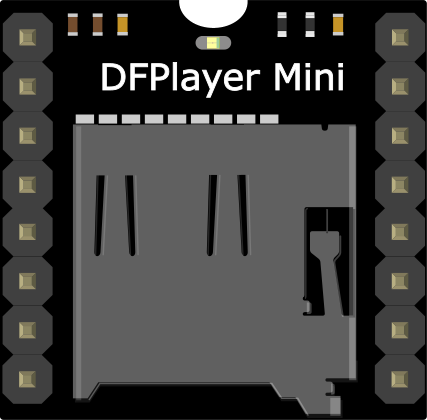
 Design with DFPlayer Mini Mp3 Player in Cirkit Designer
Design with DFPlayer Mini Mp3 Player in Cirkit DesignerIntroduction
The DFPlayer Mini MP3 Player (Manufacturer Part ID: DFR0299) is a compact and cost-effective MP3 player module designed by DFRobot. It is capable of playing audio files directly from a micro SD card, USB drive, or through UART serial communication. The module features a built-in amplifier, making it suitable for driving small speakers directly, and supports a variety of audio formats such as MP3, WAV, and WMA.
This versatile module is widely used in applications such as:
- DIY audio projects
- Interactive voice systems
- Alarm systems with audio notifications
- Educational projects
- Embedded systems requiring audio playback
Explore Projects Built with DFPlayer Mini Mp3 Player
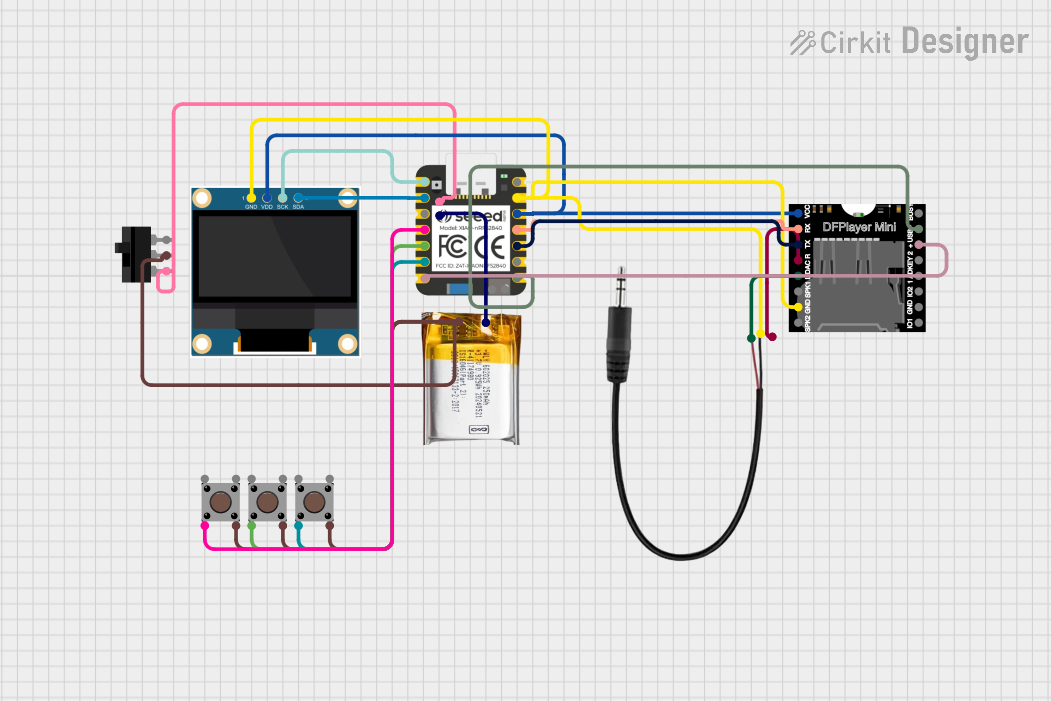
 Open Project in Cirkit Designer
Open Project in Cirkit Designer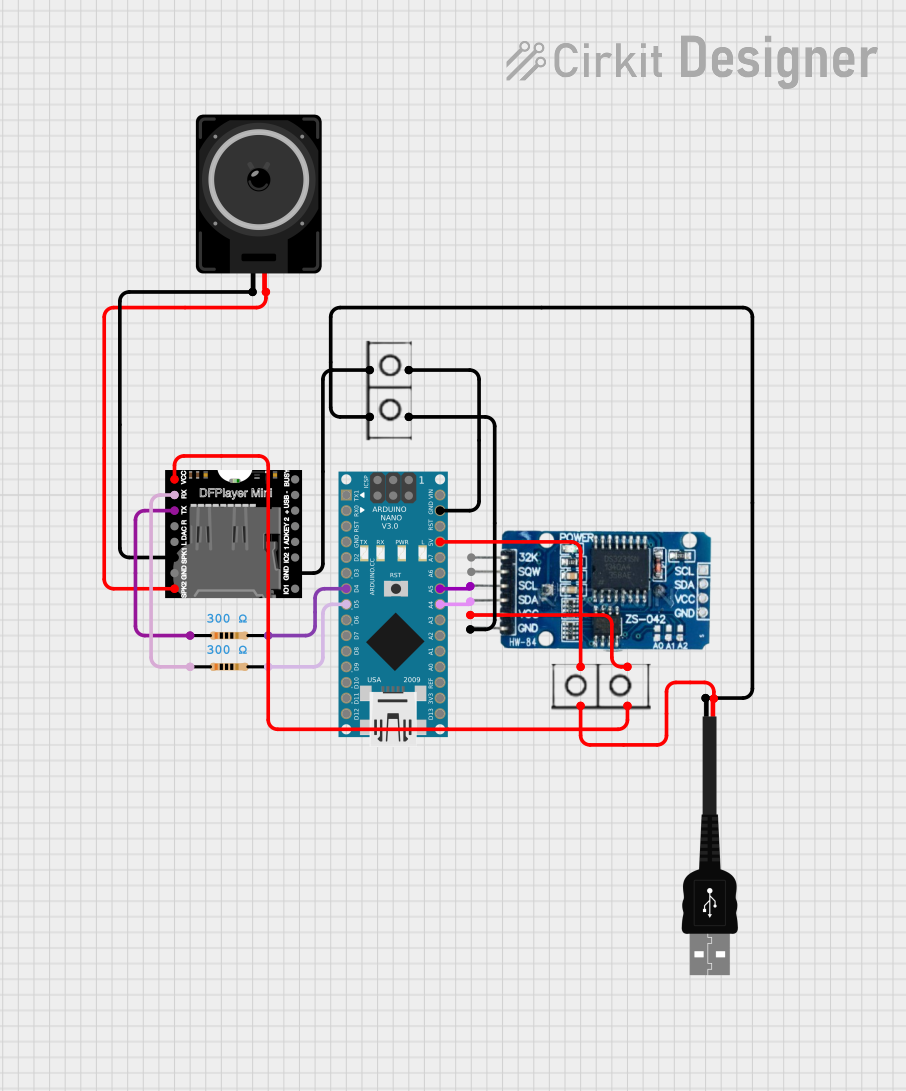
 Open Project in Cirkit Designer
Open Project in Cirkit Designer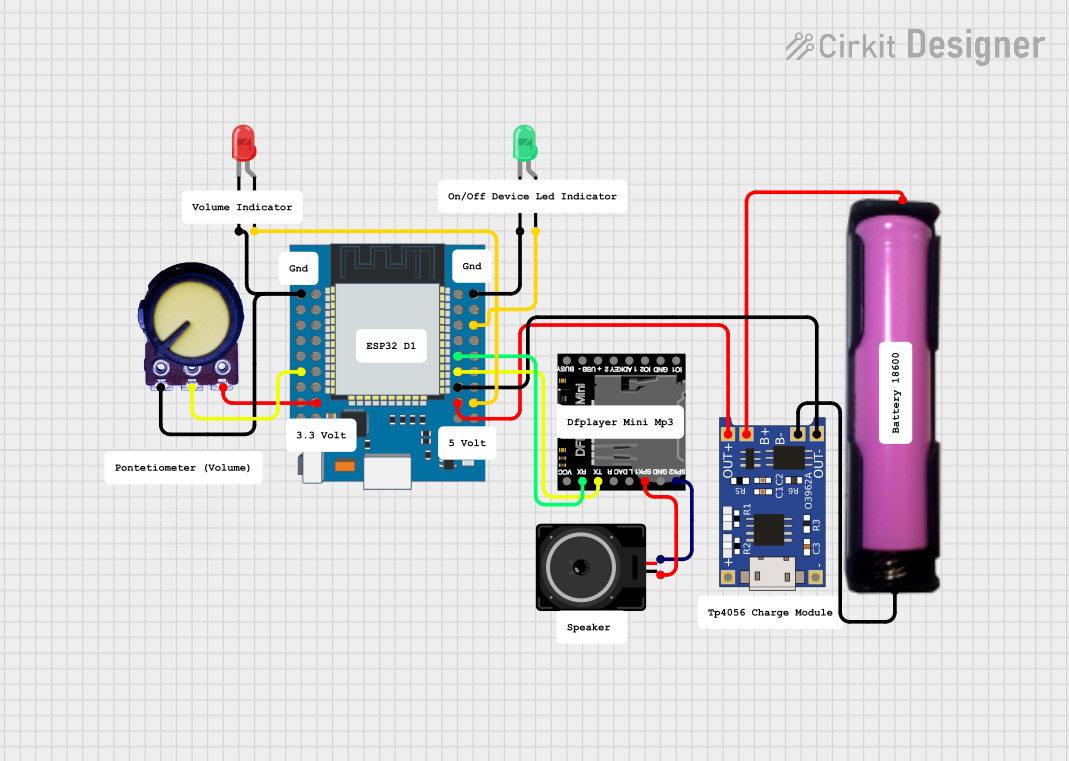
 Open Project in Cirkit Designer
Open Project in Cirkit Designer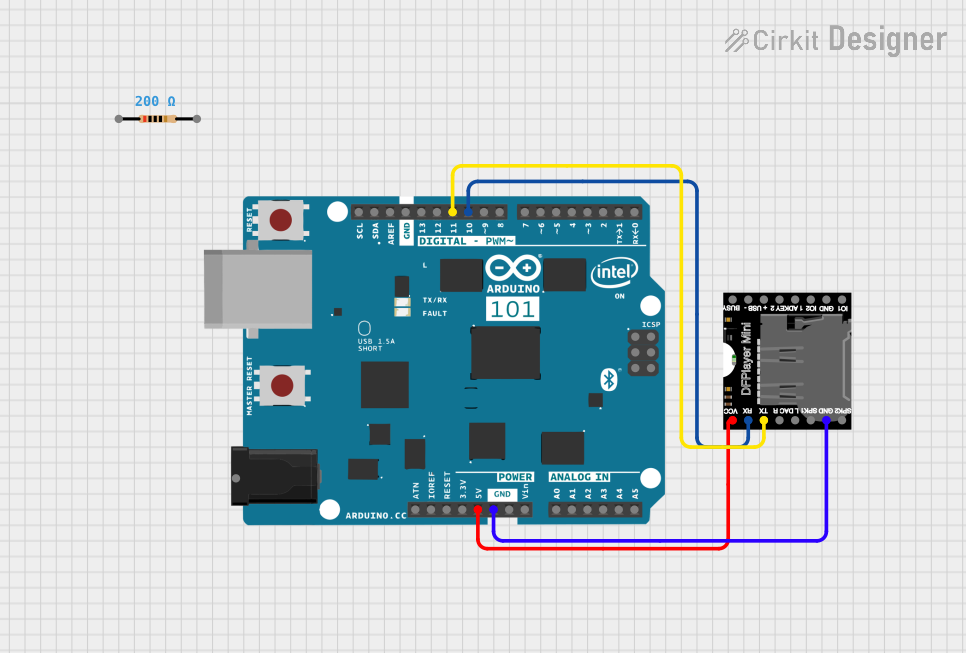
 Open Project in Cirkit Designer
Open Project in Cirkit DesignerExplore Projects Built with DFPlayer Mini Mp3 Player

 Open Project in Cirkit Designer
Open Project in Cirkit Designer
 Open Project in Cirkit Designer
Open Project in Cirkit Designer
 Open Project in Cirkit Designer
Open Project in Cirkit Designer
 Open Project in Cirkit Designer
Open Project in Cirkit DesignerTechnical Specifications
Below are the key technical details of the DFPlayer Mini MP3 Player:
| Parameter | Specification |
|---|---|
| Operating Voltage | 3.2V to 5.0V |
| Operating Current | 20mA to 30mA |
| Audio Formats Supported | MP3, WAV, WMA |
| Storage Media | Micro SD card (up to 32GB), USB drive |
| Communication Interface | UART (9600 bps default) |
| Built-in Amplifier | 3W (for 4Ω speakers) |
| Output Modes | DAC (headphone/speaker), PWM |
| Dimensions | 22mm x 30mm x 11mm |
Pin Configuration and Descriptions
The DFPlayer Mini has 16 pins, but only a subset is commonly used. Below is the pinout and description:
| Pin | Name | Description |
|---|---|---|
| 1 | VCC | Power supply input (3.2V to 5.0V). |
| 2 | RX | UART serial communication input (connect to TX of microcontroller). |
| 3 | TX | UART serial communication output (connect to RX of microcontroller). |
| 4 | DAC_R | Right channel audio output (for external amplifier or headphones). |
| 5 | DAC_L | Left channel audio output (for external amplifier or headphones). |
| 6 | SPK_1 | Speaker output 1 (connect directly to a speaker). |
| 7 | SPK_2 | Speaker output 2 (connect directly to a speaker). |
| 8 | GND | Ground connection. |
| 9-16 | Other Pins | Reserved for advanced features (e.g., IO control, ADKEY, USB, etc.). |
Usage Instructions
How to Use the DFPlayer Mini in a Circuit
- Power Supply: Connect the VCC pin to a 3.2V-5.0V power source and the GND pin to ground.
- Audio Output:
- For headphones or external amplifiers, use the DAC_L and DAC_R pins.
- For small speakers, connect directly to SPK_1 and SPK_2 pins (ensure the speaker is 4Ω or 8Ω).
- Microcontroller Connection:
- Connect the RX pin of the DFPlayer Mini to the TX pin of the microcontroller.
- Connect the TX pin of the DFPlayer Mini to the RX pin of the microcontroller.
- Storage Media: Insert a micro SD card (formatted as FAT16 or FAT32) containing audio files into the module.
Important Considerations and Best Practices
- Ensure the micro SD card is properly formatted and contains supported audio files.
- Use a decoupling capacitor (e.g., 100µF) between VCC and GND to stabilize the power supply.
- Avoid connecting both DAC and SPK outputs simultaneously to prevent damage.
- Use a logic level shifter if interfacing with a 3.3V microcontroller to avoid damaging the module.
Example: Connecting to an Arduino UNO
Below is an example of how to use the DFPlayer Mini with an Arduino UNO to play an audio file:
Circuit Diagram
- Connect DFPlayer Mini's RX to Arduino's TX (pin 1).
- Connect DFPlayer Mini's TX to Arduino's RX (pin 0).
- Connect VCC and GND to a 5V power source and ground, respectively.
- Insert a micro SD card with audio files into the DFPlayer Mini.
Arduino Code
#include "SoftwareSerial.h"
// Define RX and TX pins for SoftwareSerial
SoftwareSerial mySerial(10, 11); // RX, TX
void setup() {
mySerial.begin(9600); // Initialize SoftwareSerial at 9600 baud
Serial.begin(9600); // Initialize Serial Monitor for debugging
delay(1000); // Allow time for DFPlayer Mini to initialize
// Send initialization command to DFPlayer Mini
mySerial.write(0x7E); // Start byte
mySerial.write(0xFF); // Version
mySerial.write(0x06); // Length
mySerial.write(0x09); // Command: Play
mySerial.write(0x00); // Feedback
mySerial.write(0x00); // Parameter 1
mySerial.write(0x01); // Parameter 2 (track number)
mySerial.write(0xEF); // End byte
}
void loop() {
// No actions in loop for this example
}
Notes on the Code
- Replace
mySerial(10, 11)with the appropriate pins if using different connections. - Ensure the audio file is named correctly (e.g.,
0001.mp3) and placed in the root directory of the micro SD card.
Troubleshooting and FAQs
Common Issues and Solutions
No Sound Output:
- Ensure the audio file format is supported (MP3, WAV, WMA).
- Check the speaker connections and ensure the speaker impedance is 4Ω or 8Ω.
- Verify the micro SD card is properly inserted and formatted as FAT16 or FAT32.
Module Not Responding:
- Confirm the RX and TX connections are correct.
- Check the power supply voltage (3.2V-5.0V) and ensure it is stable.
- Add a decoupling capacitor between VCC and GND to reduce noise.
Distorted Audio:
- Ensure the speaker is not overloaded (e.g., using a 4Ω speaker with a 3W amplifier).
- Reduce the playback volume using UART commands if distortion persists.
Micro SD Card Not Detected:
- Ensure the card is formatted as FAT16 or FAT32.
- Check for physical damage or compatibility issues with the card.
FAQs
Q: Can I use the DFPlayer Mini without a microcontroller?
A: Yes, the module can operate in standalone mode using ADKEY pins to trigger playback.
Q: What is the maximum storage capacity supported?
A: The DFPlayer Mini supports micro SD cards up to 32GB.
Q: Can I control the playback volume?
A: Yes, the volume can be adjusted via UART commands or by using ADKEY inputs in standalone mode.
Q: Is it possible to play audio files in a specific folder?
A: Yes, the DFPlayer Mini supports folder-based playback. Use UART commands to specify the folder and file.
This concludes the documentation for the DFPlayer Mini MP3 Player. For further assistance, refer to the official DFRobot documentation or community forums.